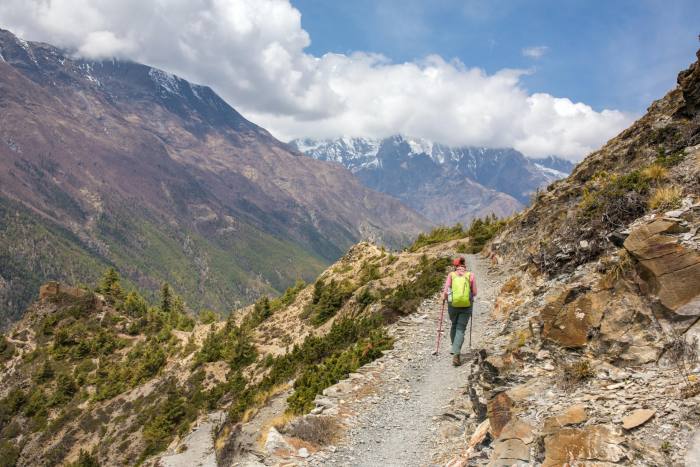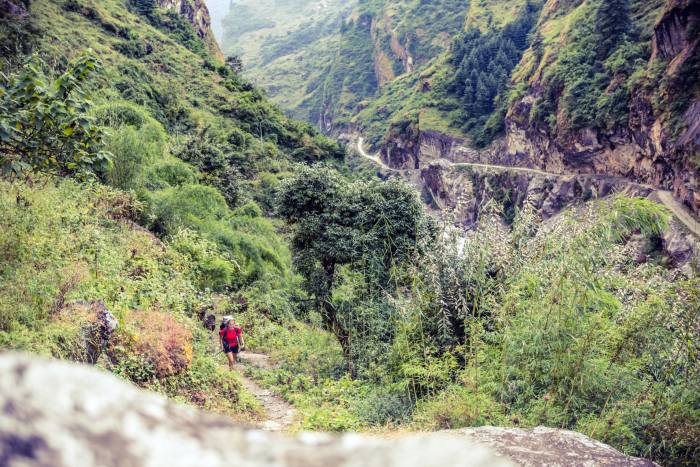Almost 30 years ago I travelled to Nepal’s famous Annapurna region for the first time. Worn out from a research trip to the dusty Tibetan plateau, a visit to the lush southern side of the Himalayas seemed the perfect antidote. In those days you needed a trekking permit from the immigration department but acquiring it was no great chore, more a fun way to experience Nepal’s happy-go-lucky bureaucracy. I took a local bus to Pokhara, then a sleepy lakeside town, and spent a few days walking the rollercoaster paths around the pretty villages of Ghandruk and Chhomrong.
Walking easy, well-maintained paths within sight of the world’s highest mountains was blissful. When I’d had enough for the day, I’d stop at a locally owned lodge, no reservation required and consequently no need for a heavy rucksack stuffed with food and camping equipment. Nepal has long been especially well set up for such trips, with its network of paths that have been used as trading routes for centuries, and frequent tea houses providing food and shelter along the way.
I have a few golden memories: a pre-dawn walk up Poon Hill to see the sun’s first rays light up the summit of Dhaulagiri, the world’s seventh-highest mountain. And languishing in hot springs next to the fast-flowing Modi river, surrounded by trees. If that all sounds free and easy, trust me: it was.
From April 1, however, such easy-going experiences will no longer be allowed. The Nepal Tourism Board (NTB), which these days regulates the trekking industry, announced in early March, just before the start of this year’s spring season, that foreign trekkers like me — or, as Nepali tourism authorities call us, “free independent travellers” — will only be issued with trekking permits if they hire a licensed guide. Independent trekking in popular national parks and conservation areas, including Annapurna, Langtang, Makalu-Barun and Kangchenjunga, will be over.
The NTB’s director Mani R Lamichhane says the two main objectives behind the ban are “to make trekking in Nepal safer and to create more employment opportunities in the country”. The US embassy has long advised against solo trekking after a string of widely reported disappearances, including that of 23-year-old Aubrey Sacco from Colorado, who vanished in 2010 while walking in the Langtang National Park.
The decision may come to be seen as an inflection point in Nepal’s development as a tourist destination. As a climber and trekker, it’s one I mourn. Across the Himalaya, the freedom of the hills is disappearing under red tape. It’s telling that Nepal’s authorities didn’t bother to consult any of the international outdoor bodies that represent those tourists who will foot the bill. On the other hand, as someone who understands the depth of poverty in Nepal, I can appreciate the need to create jobs.
The new rule has been widely welcomed by the industry. “It will create more job opportunities for the locals and also contribute to the overall safety of travellers,” Shiva Dhakal, owner of the award-winning Royal Mountain Travel told me. “It will also help prevent any negative news of weather disasters and decrease the need for search and rescue, which will help position [Nepal] as a safe destination to trek.”

Experienced hikers who like the freedom of travelling unaccompanied and prefer to take responsibility for their own safety may feel the glory days of exploring Nepal are over and will go elsewhere.
Increasingly though, Nepal’s trekking market is dominated by the much larger number of less experienced tourists buying organised trekking packages to popular destinations such as Everest Base Camp — adventures that come with guides as standard. (Ironically, the Everest region, with its strong local government, may still allow independent trekkers; it’s not yet clear.) That process has accelerated with the growth in the Indian and Chinese market.
Yet doubts remain that making guides mandatory will improve safety. Nepal will now need to train a lot more trekking guides. The Nepal Mountaineering Association runs a guide-training programme that a top British training instructor with long experience of working in Nepal described to me as approaching international standards. But the numbers going through this scheme are tiny. The majority of Nepal’s trekking guides take a government course at the Nepal Academy of Hotel Management and Tourism, whose curriculum leaves graduates woefully underprepared for the challenging Himalayan environment.

Nepal’s tourism ministry, which also oversees aviation, already has a shaky safety record. In January, a Yeti Airlines ATR 72-500 crashed on approach to Pokhara airport, killing all 72 on board, the latest in a string of fatal air crashes. The trekking industry will now be under the same scrutiny.
Nepal’s worst trekking disaster occurred in the post-monsoon season of October 2014, when Cyclone Hudhud dumped six feet of snow on the Annapurna region in 24 hours. At least 43 people died, slightly more than half of them Nepali trekking guides and other tourism workers. The true number has never been firmly established. That tragedy exposed the shortcomings of an industry that offers a warm welcome but sometimes only a facsimile of competence. We’ll soon find out how well its lessons were learnt.
Ed Douglas is the author of ‘Himalaya: A Human History’ (Bodley Head) and editor of the Alpine Journal
Find out about our latest stories first — follow @ftweekend on Twitter



